Georgian Court University
Georgian Court University (commonly known as GCU and Georgian Court) is a private Roman Catholic university in Lakewood Township, New Jersey. Founded in 1908 by the Sisters of Mercy, the university has more than 1,500 undergraduates and nearly 600 graduate students.
 | |
| Motto | Expand Possibility |
|---|---|
| Type | Private |
| Established | 1908 |
| Affiliation | Roman Catholic (Sisters of Mercy) |
| Endowment | $51.288 million[1] |
| President | Joseph R. Marbach, Ph.D. |
Academic staff | 236[2] |
| Undergraduates | 1,528 |
| Postgraduates | 594 |
| Location | , New Jersey , USA |
| Campus | Suburban |
| Colors | Blue and gold |
| Athletics | NCAA Division II – CACC |
| Nickname | Lions |
| Affiliations | Conference for Mercy Higher Education MSCHE ACCU NAICU CIC |
| Sports | 14 varsity men's and women's teams |
| Mascot | Roary the Lion |
| Website | www.georgian.edu |
Georgian Court | |
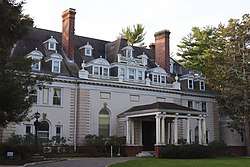 Mansion, in 2017 | |
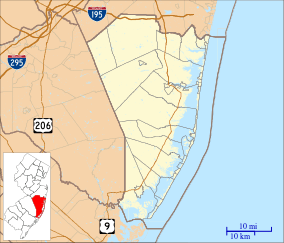 Georgian Court 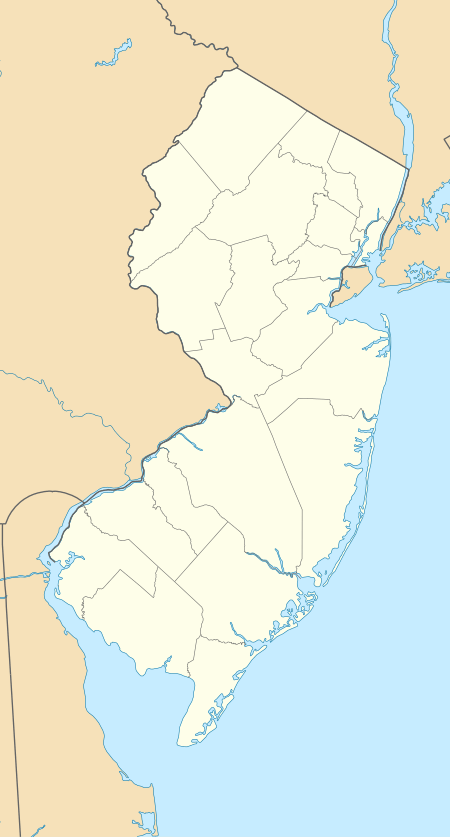 Georgian Court  Georgian Court | |
| Location | Lakewood, New Jersey |
| Area | 155.9 acres (63.1 ha) |
| Built | 1898 |
| Architect | Bruce Price, et al. |
| Architectural style | Georgian revival |
| NRHP reference No. | 78001788[3] |
| NJRHP No. | 2306[4] |
| Significant dates | |
| Added to NRHP | December 20, 1978 |
| Designated NHLD | February 4, 1985[5] |
| Designated NJRHP | August 2, 1978 |
In 2004, the institution was recognized with university status by the New Jersey Commission on Higher Education.
In 2013, Georgian Court became fully coeducational after more than 100 years as a women's college. The university is open to students of all faiths, while emphasizing its mission of Mercy, which incorporates respect, justice, integrity, compassion, and service.
The Lakewood campus (main campus) was added to the National Register of Historic Places in 1978[6] and was designated a National Historic Landmark in 1985.[7]
History
Location
The main campus is on the former summer estate (built in 1899) of the millionaire George Jay Gould, son of the railroad tycoon Jay Gould.[8] The Goulds named their home Georgian Court, probably after George or the Georgian-revival architecture.[9]
The estate was designed by Bruce Price, a New York architect, and was one of his most important residential works. He also designed three of the campus's gardens: the Italian Gardens, the Sunken Garden, and the Formal Garden. Takeo Shiota designed the Japanese Garden. In addition to the gardens, GCU has maintained much of the original architecture and the Sister Mary Grace Burns Arboretum. The estate was designated a National Historic Landmark for its architecture and its association with the Goulds.[10]
School
The Sisters of Mercy founded Mount Saint Mary College as a liberal arts school for women in 1908, in North Plainfield, New Jersey. In 1924, the sisters purchased Georgian Court estate and moved the college there, renaming it Georgian Court College.[11]
The college was granted university status by the State of New Jersey in February 2004.[12]
For more than a century, from 1908 to 2015, the institution was headed by Sisters of Mercy. The Sisters of Mercy organization continues to sponsor Georgian Court through the Conference for Mercy Higher Education.
The full transition to a coeducational institution, admitting both women and men into all academic programs, became complete at the outset of the Fall 2013 semester.
Georgian Court is the only Catholic college or university located in Central or South New Jersey. Most of its enrollment is drawn from these areas.
In 2004, university status was granted by the New Jersey Commission on Higher Education; the name was changed to Georgian Court University.
Administration and faculty
The first eight presidents (1908–2015) of the school were all Sisters of Mercy. The first male academic dean was appointed in 1967.[13]
In 2015, Joseph R. Marbach, Ph.D., became the first permanent lay president — and the first male — to take the helm of Georgian Court University.
Academics
GCU identifies itself as a vibrant learning community, attempting to adapt to the needs of today's students in its programs of study. Georgian Court offers 33 undergraduate majors through the School of Arts and Sciences, the School of Business and Digital Media, and the School of Education. Georgian Court University is nondiscriminatory and welcomes people of all faiths.
Georgian Court University is widely known for its majors in the School of Education, which include bachelor's and master's degrees, as well as many certifications in education, including concentrations in early childhood development, elementary school, secondary school and special education. The School of Business and Digital Media offers both undergraduate and MBA programs, and has expanded its global partnerships through[14] COIL (Collaborative Online International Learning).
The School of Arts and Sciences has small class sizes and offers hands-on, valuable laboratory experiences. Students also can conduct original research with faculty scholars.
Students also can work closely with faculty and staff on meaningful service projects. In 2014-15, students, faculty and staff contributed more than 90,000 volunteer hours to projects in the community and abroad.
Three of the newest undergraduate degree offerings on campus are: the Bachelor of Arts in Dance; the Bachelor of Science in Exercise Science, Wellness, and Sports; and the Bachelor of Science in Nursing.
Additional graduate programs developed in recent years include Applied Behavioral Analysis, Homeland Security and the school's online Holistic Health Studies program. In 2015, the school also launched an online graduate certificate program in Mercy Spirituality.
There are four residence halls: St. Joseph Hall, Maria Hall, St. Catherine Hall, and Mercy Hall. A large percentage of the students commute daily. Georgian Court offers classes for students who live on campus, as well as for non-residential (commuter) undergraduate and graduate students.
Evening, weekend, and online classes cater to women and men with busy schedules. Beyond classes offered on the main campus in Lakewood, Georgian Court programs are also offered at GCU at Hazlet, New Jersey (at Brookdale Community College's Northern Monmouth Campus), and other locations.
Financial aid and scholarships
About 95% of students receive some form of financial aid or scholarship assistance.
Athletics
The school colors are blue and gold, and the mascot is a lion. The Georgian Court University Lions have 14 sports teams that compete in the NCAA Division II.
The university is a member of the Central Atlantic Collegiate Conference (CACC).
GCU features a 67,000-square-foot Wellness Center equipped for athletic training, physical education and sports competitions. In addition, a 1,200-seat arena, athletics fields which offer synthetic turf, a six-court outdoor tennis center, and an abundance of training space offer student-athletes modern facilities and on-campus resources for their sports and recreational activities.[15]
Women's sports include basketball, cross country, lacrosse, soccer, softball, track & field, and volleyball.
As of fall of 2013, Georgian Court added men's sports when it became fully coeducational, adding men's basketball, cross country, soccer, and track & field.[16] Men's lacrosse was added in the spring of 2016.
"Real tennis"
One of the many historic aspects of the campus is that it houses the only "real tennis" court, also called a "court tennis" court, at an American school. This indoor tennis court was built in the Casino building (which was a "casino" in the 19th-century sense of the term: a place for social gatherings[8]).[6] Approximately forty-five real tennis courts are still in use in the world today.
Gallery
 Sunken Garden and marble stairway
Sunken Garden and marble stairway- Japanese Garden
- Sculptural detail
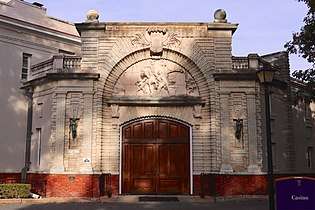 The Casino (unrelated to gambling)[8]
The Casino (unrelated to gambling)[8]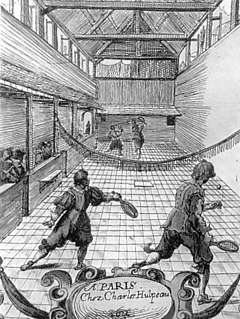 Jeu de paume (real tennis, 17th century)
Jeu de paume (real tennis, 17th century)
See also
References
- "Archived copy" (PDF). Archived from the original (PDF) on 2015-10-08. Retrieved 2015-08-19.CS1 maint: archived copy as title (link)
- "Georgian Court University". Petersons's. Retrieved 6 September 2015.
- "National Register Information System". National Register of Historic Places. National Park Service. November 2, 2013.
- "New Jersey and National Registers of Historic Places – Ocean County" (PDF). New Jersey Department of Environmental Protection – Historic Preservation Office. February 12, 2018. p. 2.
- "Georgian Court". National Historic Landmark summary listing. National Park Service. 2008-06-23. Archived from the original on 2007-12-06.
- Added on December 20, 1978: "National Register of Historic Places Inventory/Nomination: Georgian Court". National Park Service. Retrieved April 30, 2018. With accompanying pictures
- Designated on February 4, 1985.
- Lucy D. Rosenfeld; Marina Harrison (2006). History Walks in New Jersey. Rutgers Univ. Press. p. 119. ISBN 978-0-8135-3969-0.
A "casino" was added; it was both an amphitheater and guesthouse, with twenty extra bedrooms. [...] All of this was completed by 1899.
- Lorett Treese (2006). Railroads of New Jersey. Stackpole Books. p. 161. ISBN 978-0-8117-4356-3.
George Jay Gould, who named it Georgian Court, either after himself or the Georgian Revival style of his mansion[. / The sisters renamed the college] at the family's request.
- {{cite web|url=https://npgallery.nps.gov/NRHP/GetAsset/NHLS/78001788_text|title=NHL nomination for Georgian Court|publisher=National Park Service|accessdate=2020-04-06]}
- Axel-Lute, Paul (1986). Lakewood-in-the-Pines: A History of Lakewood, New Jersey. South Orange, NJ: The author. p. 84.
- Jeffries, Rosemary, "Transforming a College into a University", Presidential Perspectives: 2009/2010 Series, chapter 3, http://www.presidentialperspectives.org/pdf/2009/chapter03.pdf
- "Past Presidents". Georgian Court Univ.
- "A Brief History of the SUNY COIL Center". suny.edu. Retrieved 6 September 2015.
- "Athletics/Campus Recreation | Georgian Court University, New Jersey". Georgian.edu. Retrieved 2017-08-26.
- By SETH BERKMANNOV. 28, 2013 (2013-11-28). "Once for Women Only, Georgian Court Looks to Men's Teams to Raise Profile - The New York Times". Nytimes.com. Retrieved 2017-08-26.
External links
| Wikimedia Commons has media related to Georgian Court University. |